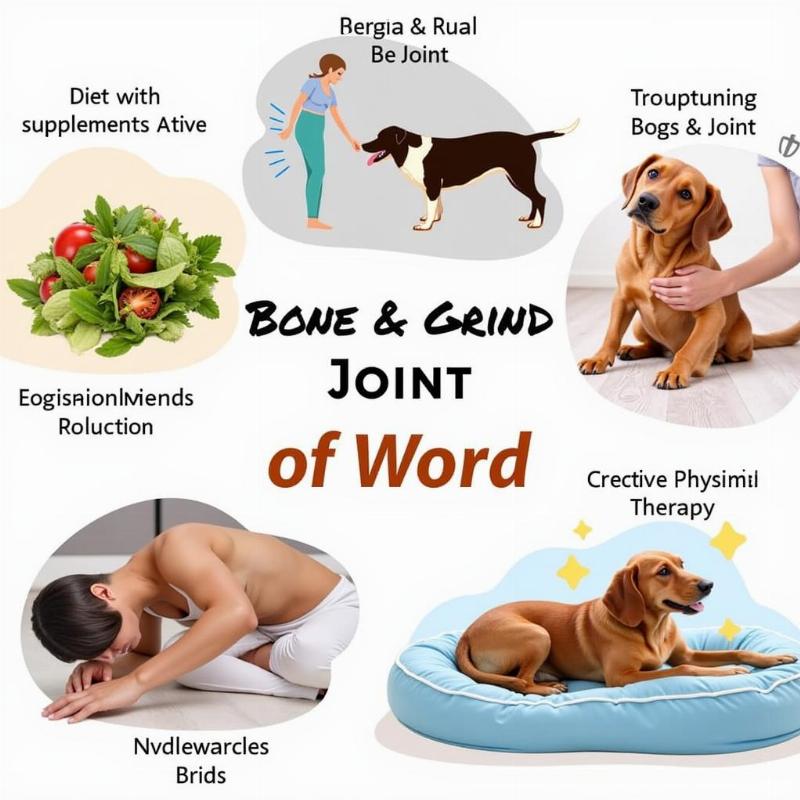A dog’s skeletal system is a marvel of biological engineering, providing structure, protection, and mobility. But have you ever wondered exactly how many bones contribute to this complex framework? Understanding the number of bones in a dog’s body, and how they function, is key to appreciating your canine companion’s physical capabilities and overall health.
Unraveling the Canine Skeleton: A Closer Look at Bone Count
While the commonly cited number hovers around 320, the exact number of bones in a dog can vary slightly based on breed and individual factors, such as the presence of a dewclaw. Similar to how humans have different skeletal structures (some people have an extra rib, for instance), tail length also plays a role in the final bone count. Breeds with longer tails will naturally have more caudal vertebrae.
The Role of Bones in Canine Health and Well-being
Beyond providing structural support, a dog’s bones serve several vital functions. They protect vital organs, such as the brain and lungs, and are crucial for movement, enabling everything from playful romps in the park to precise agility maneuvers. Bones also house bone marrow, responsible for producing blood cells, and act as a storage site for essential minerals like calcium and phosphorus.
Comparing Canine and Human Skeletons: Key Differences
While both dog and human skeletons share similarities, several key differences reflect our distinct evolutionary paths. Dogs have a more flexible spine, allowing for greater agility and range of motion. Their skulls are also shaped differently, reflecting the diverse array of breeds and their specialized functions, from scent hounds to herding dogs.
Why Knowing the Bone Count Matters
Understanding the canine skeletal system isn’t just an anatomical curiosity; it’s essential for responsible dog ownership. Recognizing the potential for skeletal issues, like hip dysplasia or fractures, and understanding how to support bone health through proper nutrition and exercise, can contribute significantly to your dog’s overall well-being and longevity.
“Ensuring a balanced diet rich in calcium and phosphorus, along with regular, appropriate exercise, is crucial for maintaining strong, healthy bones throughout a dog’s life,” advises Dr. Emily Carter, DVM, a leading veterinary orthopedist.
Protecting Your Dog’s Bones: Tips for Optimal Skeletal Health
Maintaining your dog’s skeletal health is a lifelong commitment that involves various aspects of care. Providing a balanced diet, regular exercise, and routine veterinary check-ups are crucial for preventing and addressing potential bone-related issues.
 Dog Bone and Joint Care
Dog Bone and Joint Care
“Early detection and intervention are key when it comes to skeletal problems,” adds Dr. Carter. “Regular veterinary visits can help identify potential issues before they become serious.”
Conclusion: Appreciating the Canine Skeletal Wonder
Understanding how many bones a dog has and their various functions provides valuable insights into their physical capabilities and overall health. By prioritizing bone health through proper nutrition, exercise, and regular veterinary care, you can contribute significantly to your furry friend’s quality of life and ensure they enjoy a long, active, and happy life by your side.
FAQ
- How many bones does the average dog have? The average dog has approximately 320 bones, although this can vary slightly based on breed and individual factors.
- Why does the number of bones in a dog vary? Tail length and the presence of dewclaws can influence the total bone count.
- What are the main functions of a dog’s skeleton? The skeleton provides support, protects vital organs, enables movement, and stores essential minerals.
- How can I support my dog’s bone health? A balanced diet, regular exercise, and routine veterinary checkups are crucial for maintaining strong, healthy bones.
- What are some common skeletal problems in dogs? Hip dysplasia, arthritis, and fractures are some common skeletal issues that can affect dogs.
- How does a dog’s skeleton differ from a human’s? Dogs have a more flexible spine and differently shaped skulls, reflecting their evolutionary adaptations.
- Why is it important to understand a dog’s skeletal system? Recognizing potential skeletal issues and providing appropriate care can improve your dog’s overall well-being and longevity.
Beautdogs.us is your premier destination for all things dog-related in the US. We offer expert advice on dog breeds, care, nutrition, and the latest products and services to ensure your furry friend lives a long, healthy, and happy life. From puppyhood to senior years, Beautdogs.us is your trusted source for comprehensive and engaging dog care information. Contact us today at [email protected] or +1 501-555-7529 to learn more.